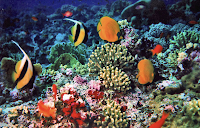 Ujung Kulon National Park is located at the western most trip of Java, Banten, Indonesia. It includes the volcanic island group of Krakatoa and other islands including Panaitan, Handeuleum and Peucang on the Sunda Strait.
Ujung Kulon National Park is located at the western most trip of Java, Banten, Indonesia. It includes the volcanic island group of Krakatoa and other islands including Panaitan, Handeuleum and Peucang on the Sunda Strait.
The park encompasses an area of 1,206 sq km (443 sq km marine), most of which lies on a peninsula reaching into Indian Ocean. The explosion of nearby Krakatoa in 1883 produced a tsunami (giant wave) that eliminated the village and crops of the coastal areas on the western peninsula, and covered the entire area in a layer of ash about 30 cm thick. This caused the total evacuation of the peninsula by humans, thereby allowing it to become a repository for much of Java's flora and fauna, and most of the remaining lowland forest on the island
 Ujung Kulon National Park (6o45' S, 105o20' E) and Krakatoa Nature Reserve (6o06' S, 105o25' E) make up a World Heritage Site. Ujung Kulon National Park lies on the extreme south western tip of Java within the administrative province of Jawa Barat (West Java) and the Kabupaten of Pandeglang.
Ujung Kulon National Park (6o45' S, 105o20' E) and Krakatoa Nature Reserve (6o06' S, 105o25' E) make up a World Heritage Site. Ujung Kulon National Park lies on the extreme south western tip of Java within the administrative province of Jawa Barat (West Java) and the Kabupaten of Pandeglang. The point to point ocean boundary encloses Ujung Kulon Peninsula and the offshore island of Pulau Handeuleum and Pulau Peucang, whilst the island of Pulau Panaitan is separated by the 10 kilometers wide Panaitan Straits. The eastern boundary follows contours along the eastern foothills of the Gunung Honje massive. Krakatoa Nature Reserve comprises the four islands of the Krakatoa group whichl lie some 60 kms to the north between Java and Sumatra. The reserve lies within Lampung administrative province, Sumatra.
Condition are tropical maritime, with a seasonal mean annual rainfall of approximately 3,249 mm. Heaviest rainfall is between October and April during the northwest monsoon, and a noticable drier periond occurs between May and September during the southeast monsoon. Mean monthly rainfall figures of 400 mm have been recorded for December and January, and 100 mm per month during May to September. Mean temperatures between 25oC to 30oC and relative humidity between 65% and 100%
 Ujung Kulon is triangular peninsula protruding from the southwest extremity of mainland Java, to which it is joined by a low isthmus some 1 - 2 km wide. The topography is dominated in the southwest by the tree, north-south aligned ridges of the Gunung Payung massive, with the peak of Gunung Payung, Gunung Guhabendang and Gunung Cikuja, forming the highest point of the peninsula. To the northeast, the relief attenuates to the low rolling hills and plains of the Telanca Pateau, and ultimately to the low-lying swamps in the region of the isthmus. To the east of Gunung Honje massive form the mainland components of the park.
Ujung Kulon is triangular peninsula protruding from the southwest extremity of mainland Java, to which it is joined by a low isthmus some 1 - 2 km wide. The topography is dominated in the southwest by the tree, north-south aligned ridges of the Gunung Payung massive, with the peak of Gunung Payung, Gunung Guhabendang and Gunung Cikuja, forming the highest point of the peninsula. To the northeast, the relief attenuates to the low rolling hills and plains of the Telanca Pateau, and ultimately to the low-lying swamps in the region of the isthmus. To the east of Gunung Honje massive form the mainland components of the park. Coastal formation include a number of raisedcoral island and their associated fringing reefs, which lie of the northern coast of the peninsula, the largest of these being Pulau Handeuleum. To the south, the coastline is characterized by sand dune formations, areas of raised coral reefs, an further west a long stretch of undermined and shattered sandstone slabs. Extensive coral reefs and spectacular volcanic formation occur along the exposed and broken west coast.
The park protect 57 rare species of plant. The 35 species of mammal include Banteng, Silvery Gibbon, Javan Lutung, Crab-eating Macaque, Leopard, Java Mouse-deer and Rusa Deer. There are also 72 species of reptiles and amphibians, and 240 species of birds.
 Parts of today's national park and World Heritage Site have been protected since the early 20
Parts of today's national park and World Heritage Site have been protected since the early 20






































